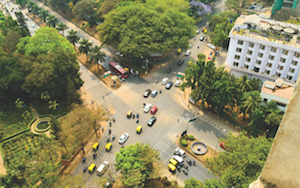The market for whisky in India is so vast, complicated, obscured and diverse it’s all but impossible to do it justice in any snapshot or soundbite. Last year, though, I was given a tiny taste of its extremes while a guest of Indian whisky maker Amrut in Bangalore.
We had toured the distillery, tasted rich and wonderful new Amrut whisky, and were heading out for dinner when my host asked me if I’d like to experience ‘happy hour’ Indian style by heading downtown. So, as dusk fell, we negotiated the chaos that is any Indian city at rush hour – or any time, come to think about it – and headed for a drink. Or at least that’s what I thought we were doing. I assumed we were going to a bar. We were not.
Our destination was what is loosely referred to as an off-licence: a concrete and glass building with a serving window on to the street. Here a steady stream of men – always men – would approach, pay about 35 rupees (35p) and be handed a quarter-size bottle of whisky. To the side of the off-licence was a concrete structure which looked a bit like a bus shelter. It had no seats, no fittings, and it stank of urine.
Along the walls ran a shelf on which each visitor placed his glass, filled it with his quart of whisky, drank it down in one, then left. No smiles, no chat, just a deflated and hurried appointment with a hooch whisky. As is the Indian way, our hosts found this sub-life a source of great merriment, openly pointing and laughing at the wretchedness before them.
We didn’t stay long and half an hour later, in one of the wealthy suburbs of the city, we went for dinner at one of the most stylish restaurants I have ever been to.
The attention to detail and service would not have looked out of place in The Ritz, the decor would have contented a Russian oligarch, and the food was of Michelin-star standard and then some. Then there was the bar – with an impressive range of Scottish malt whisky as its centre piece.
Here there was some Amrut but it isn’t common to see it in such places anywhere much further than Bangalore itself (though it is being rolled out to some degree in India now). No, this was all about single malt Scotch, presented in the most lavish way.
The two experiences were worlds apart from each other, of course, linked only in the loosest possible way by the word ‘whisky’, though the respective drinks involved had little more than yeast and water in common with each other. Those two worlds can never be reconciled and they represent two extremes, but they serve to illustrate why trying to get a grip on the market for whisky is like trying to plant a flag in the middle of the Atlantic.




